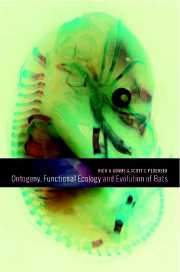Book contents
- Frontmatter
- Contents
- List of contributors
- 1 Integrating ontogeny into ecological and evolutionary investigations
- 2 Bat phylogeny: an evolutionary context for comparative studies
- 3 Early embryology, fetal membranes, and placentation
- 4 Brain ontogeny and ecomorphology in bats
- 5 Evolutionary plasticity and ontogeny of the bat cochlea
- 6 Skull growth and the acoustical axis of the head in bats
- 7 Ontogeny of the chiropteran basicranium, with reference to the Indian false vampire bat, Megaderma lyra
- 8 A theoretical consideration of dental morphology, ontogeny, and evolution in bats
- 9 Wing ontogeny, shifting niche dimensions, and adaptive landscapes
- 10 Ontogeny and evolution of the hindlimb and calcar: assessing phylogenetic trends
- 11 A comparative perspective on the ontogeny of flight muscles in bats
- 12 The ontogeny of behavior in bats: a functional perspective
- Index
7 - Ontogeny of the chiropteran basicranium, with reference to the Indian false vampire bat, Megaderma lyra
Published online by Cambridge University Press: 17 August 2009
- Frontmatter
- Contents
- List of contributors
- 1 Integrating ontogeny into ecological and evolutionary investigations
- 2 Bat phylogeny: an evolutionary context for comparative studies
- 3 Early embryology, fetal membranes, and placentation
- 4 Brain ontogeny and ecomorphology in bats
- 5 Evolutionary plasticity and ontogeny of the bat cochlea
- 6 Skull growth and the acoustical axis of the head in bats
- 7 Ontogeny of the chiropteran basicranium, with reference to the Indian false vampire bat, Megaderma lyra
- 8 A theoretical consideration of dental morphology, ontogeny, and evolution in bats
- 9 Wing ontogeny, shifting niche dimensions, and adaptive landscapes
- 10 Ontogeny and evolution of the hindlimb and calcar: assessing phylogenetic trends
- 11 A comparative perspective on the ontogeny of flight muscles in bats
- 12 The ontogeny of behavior in bats: a functional perspective
- Index
Summary
INTRODUCTION
The mammalian basicranium, including the hard- and soft-tissue structures of the auditory region, has long provided information deemed to be of systematic value (Kampen 1905; Klaauw 1931; Novacek 1977, 1993; MacPhee 1981). In fact, basicranial characters have played crucial roles historically in assessing relationships within certain orders, such as Carnivora (Flower 1869; Hunt 1974) and Primates (Gregory 1920; MacPhee & Cartmill 1986). Although the adult basicranium has been the object of most systematic studies, there are dangers in this approach. For example, sutural fusion can mask the number of osseous elements in the adult auditory bulla (Klaauw 1930). Also, cartilaginous elements, which often are components of the basicranium (Klaauw 1923, 1931), are generally lacking from macerated adult skulls. Because of such pitfalls, ontogeny has played a critical role in the study of the basicranium, by providing an additional level of analysis for evaluating the homologies of both hard- and soft-tissue structures in the adult (MacPhee 1977, 1979, 1981; Presley 1979; Wible 1986). Additionally, for phylogenetic systematics, ontogeny has provided characters in the form of transformational and/or temporal sequences (Velhagen 1997) and has been used to polarize characters (Nelson 1978) and to order multistate characters (Mabee 1993).
Chiroptera is one mammalian order within which the basicranium has not been a major contributor of systematic information, in spite of some detailed comparative treatises on selected aspects of this anatomical region (e.g., Grosser 1901; Bondy 1907; Henson 1961). There may be practical reasons why the chiropteran basicranium has been generally overlooked: many osseous auditory structures in bats are delicate and loosely held in place, and, therefore, are damaged or lost in macerated adult skulls.
- Type
- Chapter
- Information
- Ontogeny, Functional Ecology, and Evolution of Bats , pp. 214 - 246Publisher: Cambridge University PressPrint publication year: 2000
- 7
- Cited by



